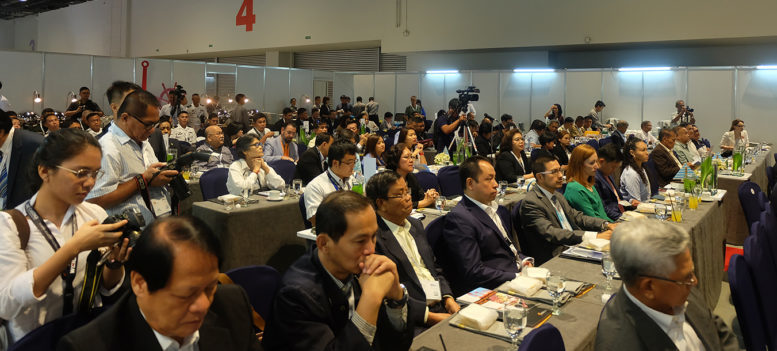The Maritime Conference 2017 was held on 12-July-2017. It was organized by the Maritime League led by its President Commo. Carlos L. Agustin (AFP Ret), and co-sponsored by the Department of Agriculture’s Bureau of Fisheries and Aquatic Resources led by its Director Commo. Eduardo Gongona (AFP Ret). The conference took place in partnership with the PhilMarine 2017 organized by Fireworks International, and was held at the SMX Convention Center, Manila.
My task was to synthesize all the speeches and present at the end of the day. This was a memorable event as it was the fourth major Maritime Conference organized by the Maritime League after the International Waterfront 2000 at the PTTC in Manila. In my view, it was a well-attended event and graced by top-level representative speakers of the U.S. Embassy and the Russian Embassy, SND Gen. Delfin N. Lorenzana, BFAR’s Commo. Eduardo Gongona, and PEZA’s BGen Charito Plaza, making the maritime conference successful and highly informative. Hopefully, the Maritime League could organize another event next year showing the nexus between maritime and aerospace safety. Until then, here is what was discussed at our fourth Maritime Conference 2017.
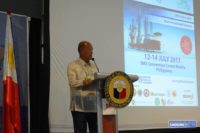 The first presentation was on the “Philippine Self-Reliant Defense Posture Program” by Philippine Secretary of Defense Gen. Delfin N. Lorenzana (AFP Ret). He highlighted the difficulties that the local defense manufacturers encounter, such as: technology and lack of skills; cumbersome procurement processes; a need to revise procurement laws; and although AFP Modernization Law supports local defense and weapons building, there is also a need for the maritime industries to dedicate resources to design, construct, upgrade or upkeep materiel for our armed forces.
The first presentation was on the “Philippine Self-Reliant Defense Posture Program” by Philippine Secretary of Defense Gen. Delfin N. Lorenzana (AFP Ret). He highlighted the difficulties that the local defense manufacturers encounter, such as: technology and lack of skills; cumbersome procurement processes; a need to revise procurement laws; and although AFP Modernization Law supports local defense and weapons building, there is also a need for the maritime industries to dedicate resources to design, construct, upgrade or upkeep materiel for our armed forces.
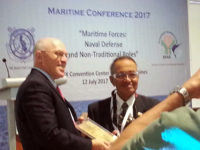 The second presentation was on “Protecting Maritime Commons” by His Excellency Michael S. Klecheski, Deputy Chief of Mission (on behalf of U.S. Ambassador Sung Kim who was in Cebu), U.S. Embassy, Manila. He stressed that the U.S. promotes peace and prosperity, navigation, over-flight, and commerce with the aim to (a) Maintain global access to trade; commitment to free market; and (b) provide their presence symbolic of its stance in favor of Freedom of the Seas; maritime access to the world’s waterways; and for its vessels to operate wherever international law allows.
The second presentation was on “Protecting Maritime Commons” by His Excellency Michael S. Klecheski, Deputy Chief of Mission (on behalf of U.S. Ambassador Sung Kim who was in Cebu), U.S. Embassy, Manila. He stressed that the U.S. promotes peace and prosperity, navigation, over-flight, and commerce with the aim to (a) Maintain global access to trade; commitment to free market; and (b) provide their presence symbolic of its stance in favor of Freedom of the Seas; maritime access to the world’s waterways; and for its vessels to operate wherever international law allows.
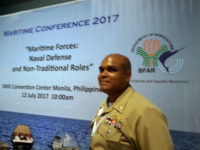 This was followed by a more detailed presentation by LCDR Patrick Panjeti (USN). He focused on providing the definition of the maritime zones, for example, 12 nautical miles of national airspace; 24 nautical miles of contiguous zone; and 200 nautical miles of EEZ. He pointed out the 10 global chokepoints in a 75-80-90 principle, where 75% is water; 80% live in coastal areas; and over 90% is seaborne trade. In the Q&A session, he was asked what he believed was the most time consuming versus what should take priority. LCDR Panjeti responded to the first part of the question indicating that the sea is very dynamic, particularly in the Sulu Sea where problems of piracy affecting global trade continue to persist; as well as the disputes surrounding the South China Sea due to maritime expansionism. VADM Ronald Mercado, Flag-officer in Command, Philippine Navy responded to the latter part of the question indicating that the Philippines is focusing more on tackling piracy, anti-terrorism, and HADR because of the effects of climate change, and cyber security.
This was followed by a more detailed presentation by LCDR Patrick Panjeti (USN). He focused on providing the definition of the maritime zones, for example, 12 nautical miles of national airspace; 24 nautical miles of contiguous zone; and 200 nautical miles of EEZ. He pointed out the 10 global chokepoints in a 75-80-90 principle, where 75% is water; 80% live in coastal areas; and over 90% is seaborne trade. In the Q&A session, he was asked what he believed was the most time consuming versus what should take priority. LCDR Panjeti responded to the first part of the question indicating that the sea is very dynamic, particularly in the Sulu Sea where problems of piracy affecting global trade continue to persist; as well as the disputes surrounding the South China Sea due to maritime expansionism. VADM Ronald Mercado, Flag-officer in Command, Philippine Navy responded to the latter part of the question indicating that the Philippines is focusing more on tackling piracy, anti-terrorism, and HADR because of the effects of climate change, and cyber security.
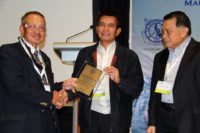 The third presentation was on “Food Security in the Maritime Domain” by the Director of BFAR, Commo. Eduardo Gongona (AFP Ret). He said that BFAR states that our maritime resources are in peril. Coral cover has dwindled to less than 1%; mangrove cover has lost over 33%; and 10 out of 13 fishing grounds are over-fished. He laid out the impacts of Illegal-Unreported-Unregulated Fishing (IUUF) as follows: (a) Net loss from Blast or Dynamite Fishing is estimated at Php3.28T yearly, or Php65.6T over the next 20 years; (b) 90% of foreign vessels operating in Philippine waters are engaged in illegal fishing; (c) In Region 2, Cagayan Valley, economic losses is estimated between $37K-$75K per foreign fishing vessel; (d) Environmental impacts: economic losses from degradation of West Philippine Sea is about Php4.5B annually; and (e) Social impacts: the encroachments of commercial fishing boats in municipal waters are displacing 37 municipal fisherfolk per day.
The third presentation was on “Food Security in the Maritime Domain” by the Director of BFAR, Commo. Eduardo Gongona (AFP Ret). He said that BFAR states that our maritime resources are in peril. Coral cover has dwindled to less than 1%; mangrove cover has lost over 33%; and 10 out of 13 fishing grounds are over-fished. He laid out the impacts of Illegal-Unreported-Unregulated Fishing (IUUF) as follows: (a) Net loss from Blast or Dynamite Fishing is estimated at Php3.28T yearly, or Php65.6T over the next 20 years; (b) 90% of foreign vessels operating in Philippine waters are engaged in illegal fishing; (c) In Region 2, Cagayan Valley, economic losses is estimated between $37K-$75K per foreign fishing vessel; (d) Environmental impacts: economic losses from degradation of West Philippine Sea is about Php4.5B annually; and (e) Social impacts: the encroachments of commercial fishing boats in municipal waters are displacing 37 municipal fisherfolk per day.
Commo. Gongona explained that the KEY strategies to achieve food security, fight IUUF effectively, and provide support to the fisheries sector are as follows: (a) Develop and expand access to new fishing grounds, for example the Philippine Rise (Benham), which has 100% coral cover and in the migration path of high-value Tuna. 15 Payaos or fish aggregating devices will be deployed by BFAR to serve as fish markers for our small-scale fisherfolk; (b) Strengthen anti-IUUF Measures by: acquiring more patrol vessels; training law enforcement personnel; intensifying resource conservation; and delineate and zone coastal land and water uses. BFAR will grow its fleet to 123 vessels and add 167 vessels by 2022; BFAR will procure drones, helicopters, and land-based monitoring systems; and will provide fisherfolk and LGU with 38-footer fiberglass patrol boats; (c) Implement science-based conservation and management measures like developing inter-LGU Coastal Resource Management Plans; (d) Promote the use of appropriate and updated technology such as 20-38 footer fiberglass fishing boats for more stability and longevity of fishing vessels; and (e) Improve fisheries post-harvest facilities and equipments.
In closing, Commo. Gongona stressed that to achieve all these, “BFAR needs strengthened collaboration with other agencies and the private sector.” At the Q&A portion, Commo. Gongona was asked his opinion on the regulation of fishing vessels in terms of the definition of limited and unlimited waters. His response was that the demise of the bigger commercial vessels will take place due to over-fishing in waters 15 km from shoreline, and only 3 gross tonnage vessels and below should be in municipal waters. He said that since our oceans are already over-fished, and we need to lessen fishing vessels and develop aquaculture instead. He believes in the need to improve fishery production by employing long-line fishing methods for Tuna fishing. Most fishing is done by purseine and long-line methods, but the best method for sustainable fishing is through the hand-line method. He said we should also promote our agricultural products, and package them better to make our products more competitive and ultimately bring in higher sales revenues.
 The fourth presentation was on the “Russian Naval Industry: the Ability to Oppose Modern Maritime Threats” by His Excellency Igor Anatolyevich Khovaev, Russian Ambassador to the Philippines. He stated that the key factor in maintaining maritime strategy is a developed shipbuilding industry. He indicated that Russia’s shipbuilding industry is modern, with highly skilled workers, is ready to cooperate with other countries, and ready for fair competition. He further stated that Russia is willing to discuss with Partners on delivery sale and transfer of technology. He noted that Russia has strategic long-term interest in its desire to help Partners develop their defense industry. He highlighted the accomplishments of the Russian Navy. He said the first submarine was constructed in Russia in 1721. The Russian Navy has built different types of ships for Russia and other countries; has exported naval equipment to more than 20 countries for $20B overall; and maintains a good Russia-Philippine naval relationship through a port visit to Manila.
The fourth presentation was on the “Russian Naval Industry: the Ability to Oppose Modern Maritime Threats” by His Excellency Igor Anatolyevich Khovaev, Russian Ambassador to the Philippines. He stated that the key factor in maintaining maritime strategy is a developed shipbuilding industry. He indicated that Russia’s shipbuilding industry is modern, with highly skilled workers, is ready to cooperate with other countries, and ready for fair competition. He further stated that Russia is willing to discuss with Partners on delivery sale and transfer of technology. He noted that Russia has strategic long-term interest in its desire to help Partners develop their defense industry. He highlighted the accomplishments of the Russian Navy. He said the first submarine was constructed in Russia in 1721. The Russian Navy has built different types of ships for Russia and other countries; has exported naval equipment to more than 20 countries for $20B overall; and maintains a good Russia-Philippine naval relationship through a port visit to Manila.
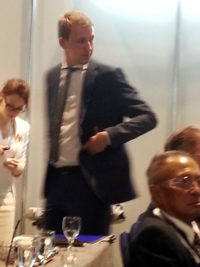 This was followed by a more detailed presentation by Sergei Lavkin, a Defense Specialist on Russian weaponry. In his presentation, he featured the diesel/electric submarines and club missiles used against terrorists in Syria land targets of ISIS; Russian frigates and submarines that destroyed land-based targets; Missile equipped Corvettes and Cutters with 250 km stealth capabilities and small Corvettes with missiles; Russian landing ships; Russian patrol ships and boats such as SBOL and Mangoost fast patrol boats; Russian assault boats such as the BK16 and BK20; Russian coastal missile system BAL-E reaching 250 kms away; and having excellent maritime security systems. In conclusion, Sergei Lavkin stated that Russian weapons could help a country survive major threats. During the Q&A portion, a question was asked about whether Russia could provide a manual so we could learn more about the diesel/electric submarine. In response, Khovaev stated that they would deal with the proper government persons when releasing sensitive weaponry design information. Another question related to whether bilateral talks were taking place between the Russian and Philippine governments. In brief, Khovaev replied stating that possibilities of Russian operations with bilateral talks between President Putin and President Duterte are going on. Lavkin added that there are specific country needs for Russian arms and weapons, and that Russia and Philippines have common concerns such as terrorism.
This was followed by a more detailed presentation by Sergei Lavkin, a Defense Specialist on Russian weaponry. In his presentation, he featured the diesel/electric submarines and club missiles used against terrorists in Syria land targets of ISIS; Russian frigates and submarines that destroyed land-based targets; Missile equipped Corvettes and Cutters with 250 km stealth capabilities and small Corvettes with missiles; Russian landing ships; Russian patrol ships and boats such as SBOL and Mangoost fast patrol boats; Russian assault boats such as the BK16 and BK20; Russian coastal missile system BAL-E reaching 250 kms away; and having excellent maritime security systems. In conclusion, Sergei Lavkin stated that Russian weapons could help a country survive major threats. During the Q&A portion, a question was asked about whether Russia could provide a manual so we could learn more about the diesel/electric submarine. In response, Khovaev stated that they would deal with the proper government persons when releasing sensitive weaponry design information. Another question related to whether bilateral talks were taking place between the Russian and Philippine governments. In brief, Khovaev replied stating that possibilities of Russian operations with bilateral talks between President Putin and President Duterte are going on. Lavkin added that there are specific country needs for Russian arms and weapons, and that Russia and Philippines have common concerns such as terrorism.
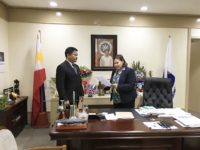 The fifth and final presentation was on “The Role of PEZA in Maritime Defense Industry Development” by PEZA Director BGen Charito Plaza. The scope of her presentation was PEZA’s performance during the period 01-July-2016 to 30-June-2017 wherein she highlighted that Philippine exports reached over $42B. Worth noting was that the Xiang Lu Dragon Group proposed project amounting to $360B utilizing 300 hectares to build a petrochemical facility complex, and an 85-storey mixed use “green” IT Center.
The fifth and final presentation was on “The Role of PEZA in Maritime Defense Industry Development” by PEZA Director BGen Charito Plaza. The scope of her presentation was PEZA’s performance during the period 01-July-2016 to 30-June-2017 wherein she highlighted that Philippine exports reached over $42B. Worth noting was that the Xiang Lu Dragon Group proposed project amounting to $360B utilizing 300 hectares to build a petrochemical facility complex, and an 85-storey mixed use “green” IT Center.
BGen Plaza also provided the details on PEZA’s role and operations. She said that PEZA is attached to the Department of Trade and Industry; promotes investments and creates employment; generates exports; has 372 operating zones nationwide and 3,995 locator countries; locator investments is led by Japan 28% compared with U.S.A 15% and Dutch 12%; by exports, the electronics and semi-conductor industry comprises 37% while IT Services comprises 11%; the major shipbuilders are Tsuneishi, Keppel, Asian Craft, Austal Phil, FBMA MARINE; and Japan provides the most support to the shipbuilding industry. PEZA has 73 Manufacturing Economic Zones; 243 Information Technology Park Centers; 21 Agro-Industrial Economic Zones; 19 Tourism Economic Zones; and 2 Medical Tourism Park Centers.
BGen Plaza explained the benefits of registering your business with PEZA. She pointed out that the business would enjoy an income tax holiday of 6-8 years for pioneer businesses, or 4-6 years for non-pioneer businesses. It would: enjoy tax and duty free importation of capital equipment; exemption from wharfage dues on import shipments of equipment; be provided domestic sales allowance; zero VAT rate to all local purchases, telecomm, power, and water bills and lease on the building; be exempted from local government tax and fees; allow employment of foreign nationals; and special multiple entry non immigrant visa for foreign investors. Altogether, she said that PEZA is a one-stop non-stop shop, and that PEZA had been cited by IFC (the private sector arm of the World Bank) as a model investment climate supporter.
BGen Plaza also spoke about PEZA’s major programs. PEZA has built: several types of economic zones in every project and city for industries such as Agro-Industrial business, aquaculture, defense industrial complex, etc; free trade zones in international air/sea ports and logistics parks; and Island Cities. In order to improve competencies, she suggested the following to address the gaps: (a) Complete the supply chain. Aim for less dependency on imports such as steel, which is abundant in the Philippines as raw material. Unfortunately, steel is still being imported; (b) Build stability and have low cost of supply of utilities; (c) Build more regional international logistics hubs; (d) Enhance and transform the workforce into a world class labor force; and (e) Take advantage of incentives and stability of policies and laws, and exemptions of ecozones and industries to the VAT zero-rating of local purchases.
During the Q&A portion, she was asked how a Renewable Energy investor could apply. BGen Plaza replied that they could drop by PEZA and fill out the application forms thereat, or download the forms from the website. Another question inquired about ecozones in Cebu where competitiveness may hamper operations. BGen Plaza replied that the common issue is allowing foreigners to own land, but we should give Filipinos the birthright to own land. Foreigners are allowed to lease land up to 75 years. However, if a joint venture is made with a Philippine entity with a ratio of 60% Filipino and 40% Foreigner, they can acquire property. Another question inquired about whether PEZA has safety nets against damages to environment, intrusion, and competition with local business; and what is being done with the mining industry. BGen Plaza replied that PEZA has put in place different types of ecozones, which will not destroy but enhance environment according to the potential of the land. It will build “green” buildings. PEZA would help industries identify where to locate best their industries. These are enhancements to business, not intrusion. PEZA would help in transfer of technology, and in so doing, build local entrepreneurs. PEZA is in discussion regarding defense industrial industries, which includes mining and steel. She emphasized that PEZA is not into the shopping malls and casino industry.
